
The Boxer Rebellion, also known as the Boxer Uprising, the Boxer Insurrection, or the Yihetuan Movement, was an anti-imperialist and anti-Christian uprising in China between 1899 and 1901, towards the end of the Qing dynasty, by the Society of Righteous and Harmonious Fists. The rebels were known as the "Boxers" in English because many of its members had practised Chinese martial arts, which at the time were referred to as "Chinese boxing". It was defeated by the Eight-Nation Alliance of foreign powers.

A human wave attack, also known as a human sea attack, is an offensive infantry tactic in which an attacker conducts an unprotected frontal assault with densely concentrated infantry formations against the enemy line, intended to overrun and overwhelm the defenders by engaging in melee combat. The name refers to the concept of a coordinated mass of soldiers falling upon an enemy force and sweeping them away with sheer weight and momentum, like an ocean wave breaking on a beach.
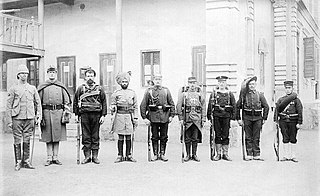
The China Relief Expedition was an expedition in China undertaken by the United States Armed Forces to rescue United States citizens, European nationals, and other foreign nationals during the latter years of the Boxer Rebellion, which lasted from 1898 to 1901. The China Relief Expedition was part of a multi-national military effort known as the Eight-Nation Alliance to which the United States contributed troops between 1900 and 1901. Towards the close of the expedition, the focus shifted from rescuing non-combatants to suppressing the rebellion. By 1902, at least in the city of Beijing (Peking), the Boxer Rebellion had been effectively controlled.
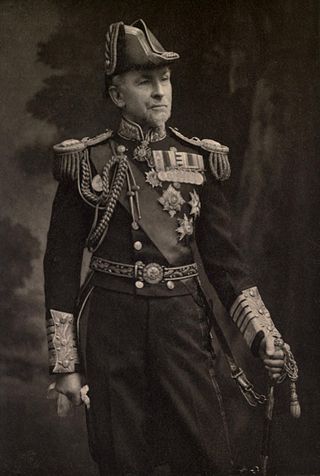
Admiral of the Fleet Sir Edward Hobart Seymour, was a Royal Navy officer. As a junior officer he served in the Black Sea during the Crimean War. He then took part in the sinking of the war-junks, the Battle of Canton and the Battle of Taku Forts during the Second Opium War and then saw action again at the Battle of Cixi during the Taiping Rebellion.

The Eight-Nation Alliance was a multinational military coalition that invaded northern China in 1900 during the Boxer Rebellion, with the stated aim of relieving the foreign legations in Beijing, which was being besieged by the popular Boxer militiamen, who were determined to remove foreign imperialism in China. The allied forces consisted of about 45,000 troops from the eight nations of Germany, Japan, Russia, Britain, France, the United States, Italy, and Austria-Hungary. Neither the Chinese nor the quasi-concerted foreign allies issued a formal declaration of war.

Clemens August Freiherr von Ketteler was a German career diplomat. He was killed during the Boxer Rebellion.
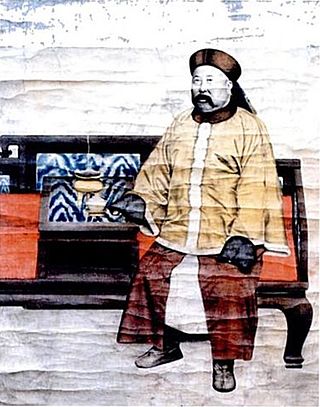
Nie Shicheng was a Chinese general of the Qing dynasty who served the imperial government during the Boxer Rebellion. Rising from obscure origins from Hefei, Anhui Province, in the early 1850s, Nie Shicheng managed to pass the county examinations for bureaucratic positions, but due to the Taiping rebellion he was forced to abandon a bureaucratic career and become a soldier.
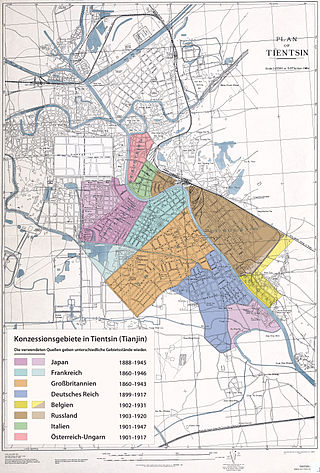
The foreign concessions in Tianjin were concession territories ceded by Qing China to a number of European countries, the United States and Japan within the city of Tianjin. There were altogether nine foreign concessions in old Tianjin on the eve of World War II. These concessions also contributed to the rapid development of Tianjin from the early to mid-20th century. The first foreign concessions in Tianjin were granted in 1860. By 1943, all the foreign concessions, except the Japanese concession, had ceased to exist de facto.

The Battle of Peking, or historically the Relief of Peking, was the battle fought on 14–15 August 1900 in Peking, in which the Eight-Nation Alliance relieved the siege of the Peking Legation Quarter during the Boxer Rebellion. From 20 June 1900, Boxers and Imperial Chinese Army troops had besieged foreign diplomats, citizens and soldiers within the legations of Austria-Hungary, Belgium, Britain, France, Italy, Germany, Japan, Netherlands, Russia, Spain and the United States.

The Battle of the Taku or Battle of Dagu Forts was a short engagement during the Boxer Rebellion between the Chinese Qing dynasty military and forces belonging to the Eight Nation Alliance in June 1900. European and Japanese naval forces captured the Taku forts after a brief but bloody battle with units of the Qing dynasty. Their loss prompted the Qing government to side with the Boxers while the Chinese army was ordered to resist all foreign military forces within Chinese territory. Allied powers remained in control of the forts until the end of the Boxer Rebellion in September 1901.
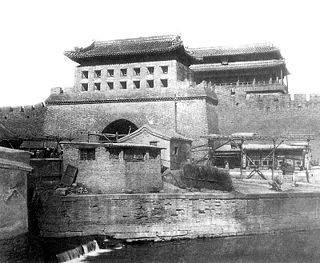
Yongdingmen, was the former front gate of the outer city of Beijing's old city wall. Originally built in 1553 during Ming Dynasty, it was torn down in the 1950s to make way for the new road system in Beijing. In 2005, the Yongdingmen was reconstructed at the site of the old city gate. This new gate is disconnected from the original road leading towards the gate and into the city.

The Battle of Tientsin, or the Relief of Tientsin, occurred on 13–14 July 1900, during the Boxer Rebellion in Northern China. A multinational military force, representing the Eight-Nation Alliance, rescued a besieged population of foreign nationals in the city of Tientsin by defeating the Chinese Imperial army and Boxers. The capture of Tientsin gave the Eight-Nation Alliance a base to launch a rescue mission for the foreign nationals besieged in the Legation Quarter of Beijing and to capture Beijing in the Battle of Peking (1900).

June 1900 was the sixth month of that exceptional common year. It began on a Friday and ended after 30 days on a Saturday.

The Gansu Braves or Gansu Army was a unit of 10,000 Chinese Muslim troops from the northwestern province of Kansu (Gansu) in the last decades of the Qing dynasty (1644–1912). Loyal to the Qing, the Braves were recruited in 1895 to suppress a Muslim revolt in Gansu. Under the command of General Dong Fuxiang (1839–1908), they were transferred to the Beijing metropolitan area in 1898, where they officially became the Rear Division of the Wuwei Corps, a modern army that protected the imperial capital. The Gansu Army included Hui Muslims, Salar Muslims, Dongxiang Muslims, and Bonan Muslims.
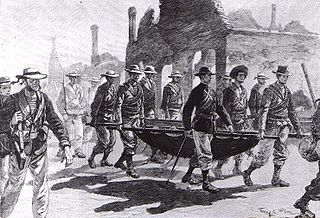
The Seymour Expedition was an attempt by a multi-national military force to march to Beijing and relieve the Siege of the Legations and foreign nationals from attacks by Qing China's government troops and the Boxers in 1900. The Chinese army and Boxer fighters defeated the Seymour armies and forced them to return to Tianjin (Tientsin). It was followed later in the summer by the successful Gaselee Expedition.
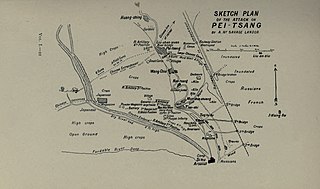
The Battle of Beicang, also rendered as the Battle of Peitsang, was fought August 5, 1900 during the Boxer Rebellion, between the Eight Nation Alliance and the Chinese Qing dynasty army. The Chinese army was forced out of its prepared entrenchments and retreated to Yangcun. The Japanese contingent led the Alliance attack; with contingents also being present from Russia, Britain, America and France.

The siege of the International Legations occurred in 1900 in Peking, the capital of the Qing Empire, during the Boxer Rebellion and led to the deaths of approximately 2500 Chinese people by western soldiers. Threatened by the Boxers—an anti-Christian, anti-foreign peasant movement—900 soldiers, sailors, marines, and civilians, largely from Europe, Japan, and the United States, and about 2,800 Chinese Christians took refuge in the Peking Legation Quarter. The Qing government took the side of the Boxers after the Eight-Nation Alliance invaded Tianjin at the Battle of the Taku Forts (1900), without a formal declaration of war. The foreigners and Chinese Christians in the Legation Quarter survived a 55-day siege by the Qing Army and Boxers. The siege was broken by an international military force, which marched from the coast of China, defeated the Qing Army, and occupied Peking.

The Battle of Langfang was a battle in the Seymour Expedition during the Boxer Rebellion, in June 1900, involving Chinese imperial troops, the Chinese Muslim Kansu Braves and Boxers ambushing and defeating the Eight-Nation Alliance expeditionary army on its way to Beijing, pushing the Alliance forces to retreat back to Tientsin (Tianjin). The Alliance force at Langfang consisted of Germans.

The Mutual Defense Pact of the Southeastern Provinces was an agreement reached in the summer of 1900 during the Boxer Rebellion by Qing dynasty governors of the provinces in southern, eastern and central China when the Eight-Nation Alliance invaded northern China. The governors, including Li Hongzhang, Xu Yingkui, Liu Kunyi, Zhang Zhidong and Yuan Shikai, refused to carry out the imperial decree promulgated by the Qing imperial court to declare war on 11 foreign states, with the aim of preserving peace in their own provinces.

Concessions of Italy in China were territories that the Kingdom of Italy controlled in China during the first half of the 20th century. After participating with other colonial powers in the war against China in the second half of the 19th century, Italy obtained a concession in Tianjin (Tientsin) with full colonial rights and some minor areas in the defeated China.


















